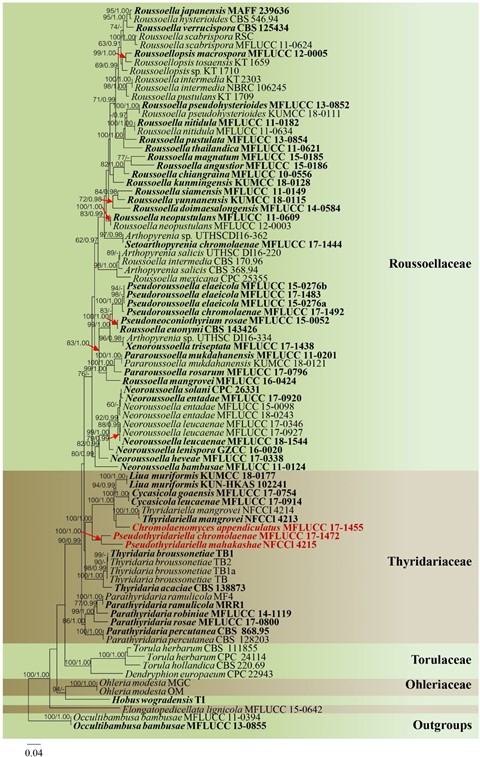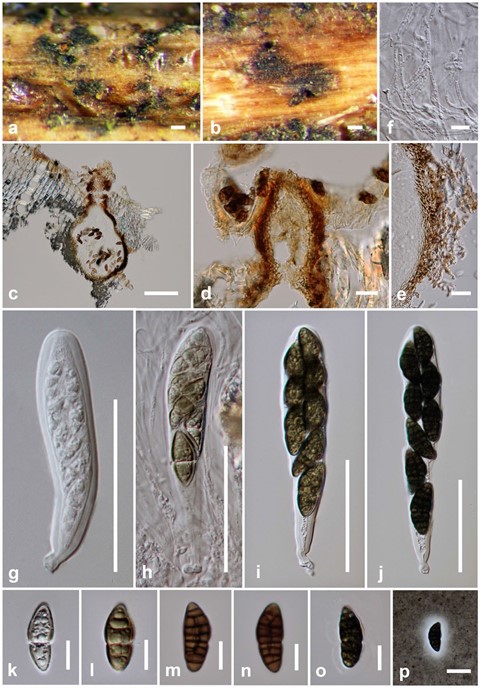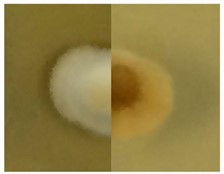Pseudothyridariella chromolaenae Mapook & K.D. Hyde, sp. nov.
MycoBank number: MB 557358; Index Fungorum number: IF 557358; Facesoffungi number: FoF 07827; Fig. 87
Etymology: Name reflects the host genus Chromolaena, from which this species was isolated.
Holotype: MFLU 20-0361
Saprobic on dead stems of Chromolaena odorata. Sexual morph:Ascomata 170–345 µm high × 95–220 µm diam. ( x̄ = 225 × 150 µm, n = 5), immersed, solitary or scattered, appearing as dark spots, coriaceous, obpyri- form, yellowish brown to brown. Ostiolar neck protruding. Peridium (10–)15–20 µm wide, several layers, light brown to yellowish brown cells of textura angularis. Hamathecium comprising 1.5–2.5 µm wide, cylindrical to filiform, septate, branching pseudoparaphyses. Asci 80–105(–135) × (14–)17–22 µm (x̄ = 100 × 18.5 µm, n = 10), 8-spored, bitunicate, fissitunicate, cylindric-clavate, straight or slightly curved, apically rounded, pedicellate. Ascospores 23–28 × 9–12.5 µm (x̄ = 25 × 10.5 µm, n = 25), overlapping, 1–2 seriate, initially hyaline to greyish brown, 1-septate when immature, becoming brown or olivaceous-brown to dark brown at maturity, ellipsoid to broadly fusiform, muri- form, with 5–8-transverse septa, and 1 vertical septum, slightly constricted at the central septum, straight or slightly curved, surrounded by hyaline gelatinous sheath observed clearly when mounted in Indian ink. Asexual morph: Undetermined.
Culture characteristics: Ascospores germinating on MEA within 48 h. at room temperature and germ tubes produced from several cells. Colonies on MEA circular, mycelium slightly raised, velvety with moderately fluffy, entire, cultures white at the surface, creamy-white in reverse with white at the margin (Fig. 88).
Pre-screening for antimicrobial activity: Pseudo- thyridariella chromolaenae (MFLUCC 17-1472) showed antimicrobial activity against M. plumbeus with a 23 mm inhibition zone, observable as partial inhibition, when compared to the positive control (17 mm), but no inhibition of B. subtilis and E. coli.
Material examined: THAILAND, Nan Province, Doi Phu Kha, on dead stems of Chromolaena odorata, 23 September 2016, A. Mapook (DPK1, MFLU 20-0361, holo- type); ex-type living culture MFLUCC 17-1472.
GenBank numbers: LSU: MT214441, ITS: MT214347, SSU: MT214395, TEF1: MT235771, RPB2: MT235807
Notes: In a BLASTn search of NCBI GenBank, the closest match of the ITS sequences of Pseudothyridariella chromolaenae (MFLUCC 17-1472, ex-holotype) with 93.82% similarity was Thyridariella mahakashae (strain NFCCl 4215, MG020436). The closest match of the LSU sequence with 97.59% similarity was Roussoellaceae sp. (strain MUT 4884, KP671726). The closest match of SSU sequence with 95.95% similarity was Parathyridaria percutanea (strain CBS 868.95, NG_062999). The closest match of the TEF1 sequence with 96.58% similarity was Parathyridaria percutanea (strain UTHSC: DI16- 300, LT797113), while the closest match of the RPB2 sequence with 87.57% similarity was T. mangrovei (strain NFCCI 4213, MG020445). In the present phylogenetic analysis, P. chromolaenae (MFLUCC 17-1472) is found closely related to Thyridariella mahakashae NFCCl 4215, which was treated as Pseudothyridariella mahakashae in this study (Fig. 84). However, P. chromolaenae differs from P. mahakashae in having smaller ascomata (170–345 × 95–220 µm vs. 250–550 × 195–500 µm) and asci (80–105(–135) × (14–)17–22 µm vs. 70–220 × 10–20 µm) with brown or olivaceous-brown to dark brown ascospores at maturity with 5–8-transverse septa, while P. mahakashae has hyaline ascospores with 3–6-transverse septa (Table 18). A comparison of the ITS (+ 5.8S) gene region of P. chromolaenae and P. mahakashaereveals 82 base pair differences (17%) across 482 nucleotides. Therefore, P. chromolaenae is described as a new species based on phylogeny and morphological comparison.
Table 18 Synopsis of Pseudothyridariella species with similar morphological features discussed in this study
| Species | Ascomata (μm) | Peridium (µm) | Asci (µm) | Ascospores (µm) | References |
| P. chromolaenae (MFLUCC 17-1472 | 170–345 high × 95–220 diam. | (10–)15–20 | 80–105(–135) × (14–)17–22 | 23–28 × 9–12.5, hyaline to greyish brown, 1-septate when immature, becom- ing brown or olivaceous- brown to dark brown at maturity, 5–8-transverse septa | This study |
| P. mahakashae (= Thy- ridariella mahakashae NFCCl 4215)
|
250–550 high × 195–500
diam. |
15–30 | 70–220 × 10–20 | 17–27 × 5–12, hyaline, 3-6
transverse septa |
Devadatha et al. (2018) |

Fig. 84 Phylogram generated from maximum likelihood analysis based on combined dataset of LSU, ITS, TEF1, RPB2 and SSU sequence data. Eighty- four strains are included in the combined sequence analysis, which comprise 4416 characters with gaps. Tree topology of the ML analysis was similar to the BYPP. The best scoring RAxML tree with a final likelihood value of − 35074.673502 is presented. The matrix had 1690 distinct alignment pat- terns, with 39.45% of undetermined characters or gaps. Estimated base frequencies were as follows: A = 0.246392, C = 0.254324, G = 0.268438, T = 0.230846; substitution rates: AC = 1.657341, AG = 4.989387, AT = 2.205689, CG = 1.285998, CT = 10.615734, GT = 1.000000; gamma distribution shape parameter α = 0.486933. Bootstrap sup- port values for ML equal to or greater than 60% and BYPP equal to or greater than 0.90 are given above or below the nodes. Newly generated sequences and new combination are in dark red bold and type species are in bold. Occultibambusa bambusae (MFLUCC 11-0394) and O. bambusae (MFLUCC 13-0855) are used as outgroup taxa

Fig. 87 Pseudothyridariella chromolaenae (holotype) a, b Appearance of ascomata on substrate. c Section through ascoma. d Ostiole. e Peridium. f Pseudoparaphyses. g–j Asci. k–o Ascospores. p Ascospores with gelatinous sheath in Indian ink. Scale bars: a–c = 100 µm, g–j = 50 µm, d, e, p = 20 µm, f, k–o = 10 µm

Fig. 88 Culture characteristic on MEA: Pseudothyridariella chromolaenae (MFLUCC 17-1472)
